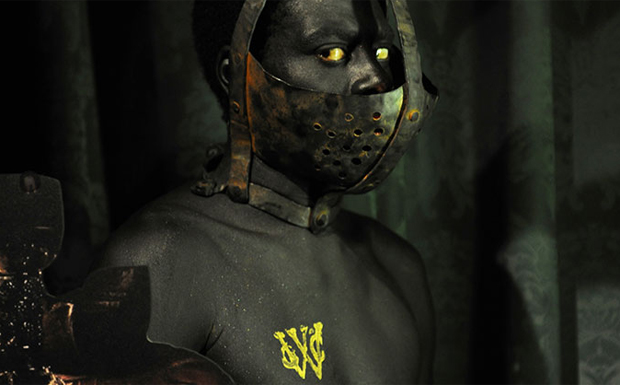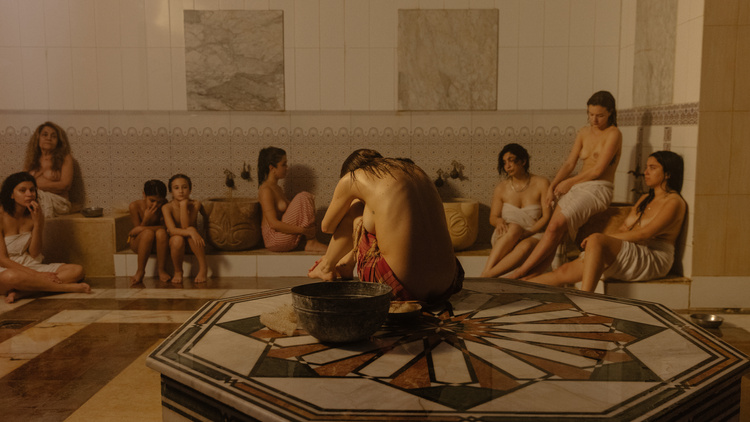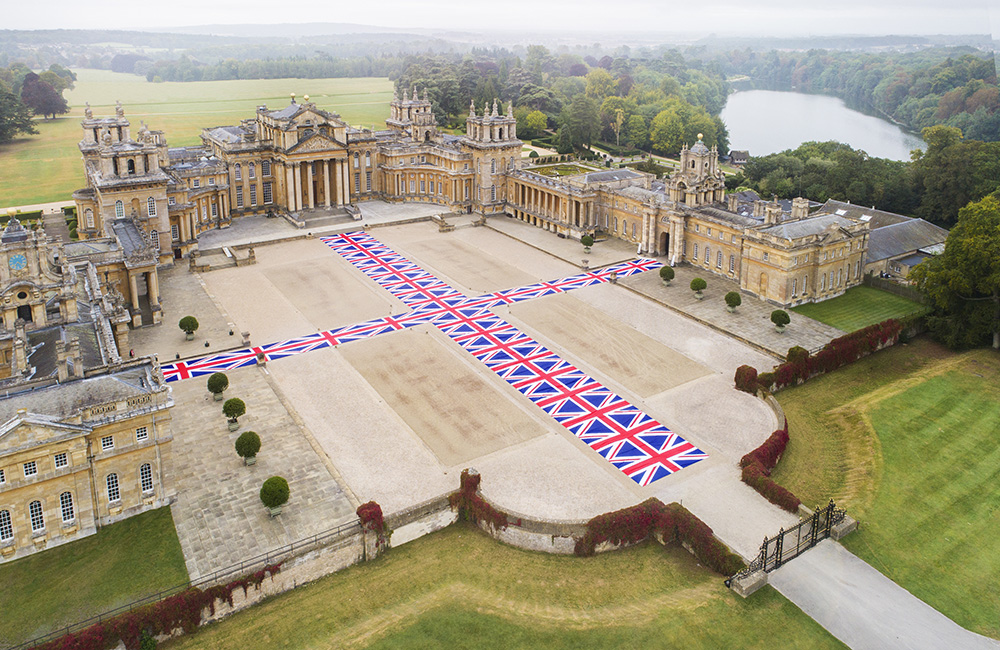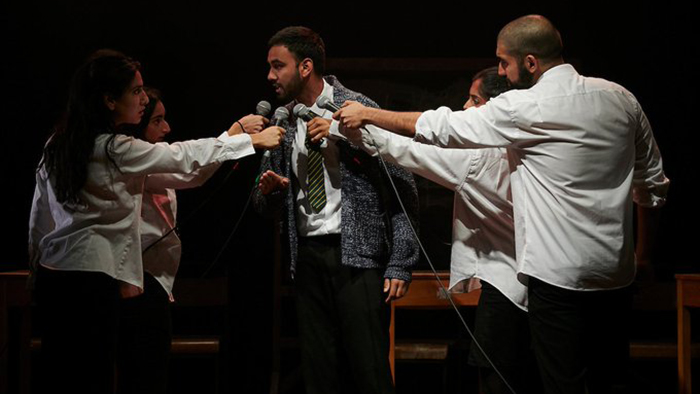
Exhibit B (Photo: © Sofie Knijff / Barbican)
This is an account of the policing of the demonstration organised by Boycott the Human Zoo Campaign on the opening night of Brett Bailey’s theatrical installation Exhibit B presented by the Barbican at the Vaults Waterloo. Written by Julia Farrington, associate arts producer, Index on Censorship, it is part of Index’s short series of case studies looking into policing of arts events in the UK.
The case studies have been written to accompany Index on Censorship’s information packs on the legal framework underpinning artistic freedom of expression in this country. In this case the report relates to the pack on Public Order which addresses the rights, responsibilities, roles and rules around policing of public order incidents in response to artistic expression.
The production was closed on the advice of the police to the organisers of Exhibit B: to cancel the opening night 23 September 2014, and all subsequent performances 24–27 September. Immediately prior to the Barbican dates, the work was shown as part of the Edinburgh Festival. A 2012 production of Exhibit B drew condemnation in Berlin.
Interviewees
Louise Jeffreys, director of arts Barbican Centre
Lorna Gemmell, head of communications, Barbican Centre
Kieron Vanstone, director, The Vaults
Sara Myers, journalist, who started the Boycott the Human Zoo campaign
Lee Jasper, policing director for London 2000-2008 Mayor of London office, who liaised with the police on behalf of the Boycott the Human Zoo campaign.
Julia Farrington also approached the British Transport Police (BTP) and the Metropolitan Police (The Met). Farrington received written answers from Assistant Chief Constable Stephen Thomas (BTP) and applied for answers via Freedom of Information requests as recommended by The Met. (The answers from FoI are outstanding, though in the main the same ground is covered by BTP.)
Background
The Barbican’s publicity material described Exhibit B as: “a human installation that charts the colonial histories of various European countries during the nineteenth and twentieth centuries when scientists formulated pseudo-scientific racial theories that continue to warp perceptions with horrific consequences.”
Boycott the Human Zoo is a coalition of anti-racism activists, trade unions, artists, arts organisations and community groups. The campaign, which was formed in response to Exhibit B, objected to the work on the following grounds:
“The human zoo is an ugly stain on European history. The recreation of viewing Africans as caged exhibits is a pastime society long lost the stomach for. On 23rd Sept 2014 artist Brett Bailey and the Barbican, are set to resurrect this unjustifiable practice. Despite the condemnation of race campaigners, they [the Barbican] remain insistent that this piece is ‘challenging racism and cultural ‘othering”.”
Online petition with change.org
Boycott the Human Zoo set up an online petition on change.org calling on the Barbican to decommission the work and withdraw it from their programme. The key objections named in the petition were:
“[It] is deeply offensive to recreate ‘the Maafa – great suffering’ of African People’s ancestors for a social experiment/process.
Offers no tangible positive social outcome to challenge racism and oppression.
Reinforces the negative imagery of African Peoples
Is not a piece for African Peoples, it is about African Peoples, however it was created with no consultation with African Peoples”
The petition was signed by over 22,000 people.
The Barbican response
On 22 September, the Barbican issued a response to Boycott the Human Zoo’s online petition, which concluded:
“[We] accept that the presentation of Exhibit B has raised significant issues and undertake to explore these further. But we cannot accept that the views expressed, however strongly felt, should be a reason to cancel the performances. We have an undertaking to our committed performers and to our audiences who wish to explore these difficult subjects. We state categorically that the Barbican is not neutral on the subject of racism; we are totally opposed to it and could not present a work that supported it.
“Finally, we fully accept your right to peaceful protest if you disagree with this conclusion; in return we would ask that you fully respect our performers’ right to perform and our audiences’ right to attend.”
Dialogue
Boycott the Human Zoo campaigners were in communication with senior management at the Barbican from the launch of the campaign about their intended actions. Campaigners also contacted the police about planned picketing. On 11 September, Barbican senior staff and board members met with Boycott leaders to discuss their campaign and their opposition to Exhibit B.
The night before the opening of Exhibit B, Nitrobeat, the black theatre company who had been responsible for casting the show, organised a public debate at Theatre Royal Stratford East in response to the boycott. Louise Jeffreys spoke on the six person panel in support of Exhibit B; Sara Myers spoke for the Boycott the Human Zoo Campaign. About 150 people attended.
Police involvement in the lead up to the opening of Exhibit B
The Boycott the Human Zoo campaign went live on 19 August. As soon as he was made aware of it, Kieron Vanstone, director of The Vaults, anticipated the possible need for additional security. He met with the Barbican’s head of security to discuss and contacted British Transport Police (BTP). Kieron Vanstone said the police were slow to respond to his requests.
Louise Jeffreys commented that: “Considerable effort was put in by Kieron and Nigel Walker (head of security at the Barbican) to make sure that the police were aware of … what might happen there. It wasn’t that they weren’t informed, they absolutely were.”
Three different police forces were involved in policing the installation:
British Transport Police
The Vaults is directly under Waterloo station, and falls under the jurisdiction of BTP. It is a large space built into the railway arches approached by a tunnel. Assistant Chief Constable Steve Thomas of the BTP, who responded to Index’s questions relating to the policing of the event, said that “this case was dealt with as a low level event by our ‘B’ Division Operations Unit and their Neighbourhood Policing Unit at Waterloo”.
Regarding the planning of police resources for the opening night, the following is an extract from the e-mail written to Kieron Vanstone on 19 September: “My Operations department are in contact with the Metropolitan Police planning team and I have not been informed regarding extra resources for the event as yet. I have 2 PCs [Police Constables] and 4 PCSOs [Police Community Support Officers] on duty on Tuesday plus 1 Sergeant. I can’t promise all personnel to be there but there will be a police presence.”
Metropolitan Police
While BTP has jurisdiction over the Vaults, as ACC Thomas explained: “the roadway and areas where protestors were expected to gather are within the jurisdiction of the Metropolitan Police Service.” On 22 September, Lee Jasper of the Boycott met with Sgt Tom Cornish of The Met and Kieron Vanstone to agree to a plan for the picketing. The three visited the venue together and decided where the barriers should be placed. Kieron Vanstone noted that the meeting was very affable and everyone was in agreement. At the time, Lee Jasper said that he thought the venue was going to be problematic.
City of London Police
The Barbican Centre itself comes under the jurisdiction of the City of London Police. Police attended two protests at the Barbican, both of which went ahead without incident. On 14 September, the City of London Police attended a Boycott the Human Zoo campaign protest of about 165 people outside the Barbican when campaign leaders attempted to deliver a hard copy of the petition before the production opened. The Barbican directed the campaigners to hand it in to the head of security. This was rejected by the boycott organisers. It was the campaigners’ understanding that they would hand it to a member of the Barbican board, who was present on that occasion but did not come down to receive the petition, they said. The Barbican told Index that there was no board member present at the time. Boycott the Human Zoo returned to the Barbican on 16 September with about 50 people and delivered a hard copy of the petition to Barbican Managing Director Sir Nicholas Kenyon. There was a low level police presence on both occasions. The City of London Police also sent a unit of officers to the Barbican Centre on the opening night, in case there was protest at that location.
ACC Thomas, commenting on the allocation of policing on the night, said: “Like BTP, the Metropolitan Police Service decided to police the event with their Waterloo Neighbourhood Policing Team – a decision based upon the information and intelligence known to them at the time and upon their discussions with the organiser of the protest. Once requests were made by the officers at the event for assistance, more Metropolitan Police Service and BTP officers attended to deal with the protesters. Often when an event happens and there is a shared event footprint, there is an agreement to place all officers involved under the command of one of the Police Forces involved. This was not done on this occasion as both Forces anticipated a low level peaceful protest that did not necessitate this approach.”
Policing on the night
Allocation of officers
On the opening night of the installation, just one of the two BTP PCs, allocated to the picket, attended. ACC Thomas stated: “The Sergeant, two Constables and four PCSOs mentioned in the e-mail (see above) were the entire shift on duty at Waterloo Station that evening. Obviously, the shift had other operational duties to perform and there were calls from the public to deal with. As such, it was never the intention for the entire shift to be posted to the event. In the planning for the event and on the night, an operational decision was made to post one Constable and two PCSOs to the event.”
At the entrance to the venue
There were problems from the start of the demonstration with implementing the plan agreed by everyone the previous day. Accounts differ as to why this broke down. According to Lee Jasper, the barriers were not configured as agreed; Kieron Vanstone, director of The Vaults, says the plans were followed, but the protesters breached the barriers. But the result was the demonstration was right up against the doors to the venue. There is CCTV footage of the protesters up against the doors of The Vaults, and the organisers were concerned that they were trying to force their way into the building.
“We were never interested in what was happening inside. We didn’t want to get in. We wanted to stay on the outside and stop people going in,” said Sara Myers.
Seven security guards were caught between the doors and the protesters. At this point, it became clear to Kieron Vanstone that the scene at the entrance had “descended into chaos.” At around 6:30pm, just when the first performance was scheduled to begin, he decided to evacuate the building: performers, audience and senior Barbican staff, including Louise Jeffreys and Nigel Walker, head of security.
Call for additional police
The PC on duty called for backup officers. ACC Thomas reported “that ‘about’ 12 BTP officers and 50 Metropolitan Police Service Officers attended the event in response to the ‘calls for assistance’ from the officers dealing with the protesters. However, it is not possible to confirm exactly how many officers … actually attended this event … because the radios of both Forces do not work in the tunnel and so exact numbers may not have been recorded.”
When Lee Jasper of the Boycott saw the additional police arriving at the end of the tunnel, he went to meet them. The police, who had brought dogs with them, were preparing to clear the tunnel. “I spoke to Tom Cornish [of The Met] and made it clear that I thought that would be the biggest mistake. The tunnel amplified the sound of the drums and the whistles, there were a lot of people in a small space, feelings were running high and the situation could escalate. I repeated my view that the event should be closed down,” Lee Jasper said.
Inspector Nick Brandon, the senior officer in charge from BTP, went to speak to the campaign organisers. Sara Myers told Index: “[Brandon] didn’t know anything about the show or what had happened over the past month, so I told him about the boycott. He asked me what we wanted and I said we wanted the show to be closed down. And that if it wasn’t closed down, we would come back every evening to picket the show. He told me that they hadn’t got the resources to police this every day. He said ‘we need to be out fighting crime. This is much ado about nothing, and we haven’t got the resources to police it’.”
Police advice
After evacuating the building, Kieron Vanstone returned to the main entrance to find that backup officers had arrived. He described the scene as: “Fifty police, riot dogs, helicopters overhead – just a huge police presence. I was in real shock. The BTP inspector asked me what I would like to do… I couldn’t see a way that we could avoid the protest [continuing], so then he recommends that he doesn’t think we should continue the show for the rest of the duration”.
Kieron Vanstone called the Barbican’s senior management team, who had returned to the Barbican Centre, and passed on the recommendation of the police to discontinue the show for the whole run. The team asked his opinion, and Vanstone said he couldn’t see a way to continue the show.
“That was definitely influenced by the amount of fear that had been put into me as well as that I couldn’t physically see a way to get people into the building in a safe way,” Vanstone said. “I kind of know as well that the police used me to make that decision to get the protesters to disperse.”
ACC Thomas reported that Kieron Vanstone asked Inspector Brandon’s advice and he was told “that the production should cease at that location and another location should be considered.” ACC Thomas added:
“Of course, this was ‘police advice’ and the final decision (as it always is) to continue or cancel an event lies with the event organiser. On 23rd September the event organiser appears to have decided to cancel the event that night and on all subsequent nights, based upon the advice of Inspector Brandon.”
As the senior management team travelled back to the Barbican, as yet unaware of the police advice, they had been determined to open the show the next night. Louise Jeffreys said: “We need[ed] to get the police behind this again and it was important that we went back and tried again [the following night].”
But when Kieron Vanstone got in contact to tell them of the recommendation, the senior management team agreed to follow the police advice.
When asked about the police advice to cancel all five performances, ACC Thomas explained that Inspector Brandon who attended the Vaults during the protest, based his opinion on “his assessment of the venue entrance in a narrow arch of some 50 foot wide and 400 foot long, with very poor lighting and no available police radio communications (due to the tunnel roof), the difficulty of ticket holders passing through the protesters, the difficulty of ‘controlling’ the 150 or so protesters in that environment and the large number of police officers it would have required.”
Request for a written guarantee from the venue
Sara Myers said that one of the Boycott partner organisations requested written confirmation that the event would be closed for all subsequent planned performances, adding that they would not disperse until this confirmation had been produced.
Five police officers entered the Vaults to talk to Kieron Vanstone. He commented: “They made me do a written letter, and go back out to the protesters, [which is online at Youtube], and present the written letter to say we were not going to continue the show. I didn’t actually do the letter straight away. I went out there and spoke to [the protesters] first, then came back in…They [the police] came back to me and go ‘No, we need to write the letter’. So very forceful about that, [they] very much need to use me.”
Assessment of the police decision
The Barbican felt that the policing had been inadequate and disorganised. Louise Jeffreys said: “Our [risk assessment] never had anything ‘What if the police don’t turn up?’…. It didn’t even cross our minds that that would be something we would have to deal with, so of course … we weren’t really prepared. So it happens in a second and then because it’s happened you could change it [the decision to accept the police’s recommendation], but changing it is a huge, huge thing.”
Sara Myers of the Boycott the Human Zoo campaign was pleased that they had gotten the result that they wanted and felt well supported by the police.
Sara Myers commented: “It gave us a victory with the police – it showed the police supporting black people’s right to protest, and it gave us hope then we might get another victory another time. The negative portrayal came from the media, never from the police. I had a long conversation with the police on the night. They had been called to investigate an alleged assault, but no arrests were made, no damage to property, but we were portrayed as this violent mob [in the media].”
The Barbican senior management team met with Kieron Vanstone the following day to consider their options, including whether they could mount the exhibition elsewhere, but it was agreed that it wasn’t feasible. They also questioned the consequences of going against police advice.
The Barbican’s Head of Communications Lorna Gemmell said: “I think the question is ‘How does any arts organisation take the decision to go against police advice in the scenario where there is actual risk to public safety?’. That’s what we were discussing the next day.”
The Barbican decided to stand by the decision reached the previous night, rather than contest it. They were told the next day that the police were investigating violent disorder associated with the protests. They were constrained about what they could say publicly because of the investigation.
Louise Jeffreys commented:
“Knowing that made it even harder to try and get the decision overturned and it also made us believe that it [had been] unsafe. Because why would you be pursuing violent disorder if it was safe?”
The Barbican issued a statement:
“Last night as Exhibit B was opening at the Vaults it became impossible for us to continue with the show because of the extreme nature of the protest and the serious threat to the safety of performers, audiences and staff. Given that protests are scheduled for future performances of Exhibit B we have had no choice but to cancel all performances of the piece.”
In retrospect, Louise Jeffreys thinks that “the case should have been escalated with the police”, but Barbican’s senior management felt constrained and, to an extent, reassured that action was being taken by the police. “We felt it was being handled because of the investigation into violent disorder,” Jeffreys said. Statements by the security guards on duty on the night were subsequently withdrawn. The police inquiry was dropped.
The Boycott campaign also issued a statement on the closure of the installation:
“#boycottthehumanzoo would like to make it clear that at no point during the protest was anyone hurt or threatened. Police attended the scene after reports of violence, but seeing that the blockade remained peaceful, made no arrests.”
Complaint from an audience member
There was an investigation into a complaint by a member of the public to the police about the policing on the night. In response to an Index question about this, ACC Thomas wrote:
“The complainant had purchased a ticket for the event on 23rd September 2014. When it was cancelled, they complained that: ‘Police failed to ensure the legal right of freedom of expression by those persons who had wished to see the play.’ The complaint was made to the Metropolitan Police Service and passed onto BTP. The complaint was investigated ‘locally’ on B Division of BTP and the complaint was found to be ‘partially upheld’. The complainant was informed of this and provided with a copy of the Investigating Officer’s report. The complainant appears to have been satisfied with this.”
The Barbican asked for a written statement from the police, confirming their recommendation, which they did not receive.




